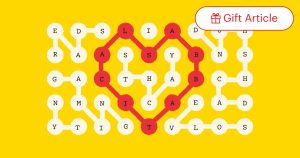The New York Times has added an intriguing twist to puzzle-solving by introducing a captivating blend of the classic crossword and word search games. This innovative puzzle fusion, known as Two-in-One, challenges regular puzzle enthusiasts and word game aficionians alike by combining the intellectual stimulation of crossword puzzles with the visual scanning techniques required in word searches. The game starts with a seemingly traditional crossword layout, but once the crossword is completed, the game is only half done.
Subsequently, the filled crossword grid transforms into a word search, where players must locate and highlight specified words within the grid. This dual-function puzzle is an engaging novelty that redefines the boundaries of traditional word games, offering a fresh experience that simultaneously stimulates diverse cognitive abilities. Its introduction in The New York Times underlines the newspaper’s commitment to providing unique, mind-stimulating content to its readers, adding a new dimension to their daily puzzle-solving routine.
How to Play Strands: A Guide
To effectively play Strands, you need to first familiarize yourself with the intricate mechanics and overarching strategies that govern this captivating game. As a beginner, you should start by understanding the basic premise of the game, which involves connecting and intertwining different ‘strands’ or elements to achieve a specific outcome. The key to mastering Strands lies in the careful planning, thoughtful decision-making, and a keen understanding of how each element interacts with the others.
Before you plunge into the game, ensure that you have a thorough understanding of the rules, which are often complex but integral to the gameplay. You can find this information in the game’s manual or through online forums dedicated to Strands. It’s also beneficial to watch tutorials or gameplay videos, which can provide invaluable insights into advanced strategies and tactics.
As you begin to play, remember that Strands is not just about quick reactions; it’s a game of strategy. Concentrate on developing a long-term plan rather than just responding to immediate challenges. Analyze your options, consider the potential outcomes of each action, and choose the one that will bring you the most benefit in the long run.

Experimentation is also an important part of learning Strands. Don’t be afraid to try different strategies, even if they seem unconventional. You might discover a new approach that works better for you. It’s also crucial to learn from your mistakes. If a strategy doesn’t work as expected, try to understand why and adjust your tactics accordingly.
Lastly, remember that practice makes perfect. The more you play, the better you’ll become. So, keep refining your strategies, learn from your experiences, and enjoy the process. In no time, you’ll find yourself navigating the complex world of Strands with ease and confidence.
Finding Hints and Clues for Strands
Unearthing hints and clues for strands can be a fascinating and rewarding endeavor, akin to solving an intricate puzzle or deciphering an enigmatic riddle. Strands, in this context, could refer to multiple things – strands of a story, strands of DNA for genetic research, or strands of information in a complex data set. Regardless of the context, the process of discovering and interpreting these clues often involves meticulous observation, sharp analysis, and shrewd deduction.
One common method employed in finding hints and clues for strands is pattern recognition. This involves identifying recurring themes, similarities, or differences within the strands that may point towards a larger picture or a hidden meaning. For instance, in a narrative, the recurring use of certain symbols, phrases, or character traits could hint towards a deeper thematic strand.
In the realm of data analysis or research, the clues often lie in anomalies or outliers within the data strands. These aberrations could indicate an underlying trend or phenomenon that isn’t immediately apparent. This process could involve the use of sophisticated tools and technology, ranging from data mining software to advanced statistical models.
When it comes to genetic research, the clues are typically found in the variations in the DNA strands. These variations could potentially reveal valuable information about an individual’s genetic makeup, ancestry, or susceptibility to certain health conditions. The interpretation of these clues often requires a deep understanding of genetics and biology.
In conclusion, finding hints and clues for strands is a complex but intriguing process that requires a combination of keen observation, analytical skills, and advanced tools. It is a task that calls for patience and perseverance, but the rewards it offers – in the form of new insights, discoveries, or revelations – are well worth the effort.

Celebrating Your Victory: Tips and Ideas
Celebrating your victories is an essential element in the journey to personal growth and self-fulfillment. It’s crucial to acknowledge your triumphs, regardless of whether they’re colossal career milestones or minor daily accomplishments. You can make the celebration of your victories more memorable by using creative tips and ideas. One of these could be journaling about your achievement as it serves as a constant reminder of your resilience and determination. Sharing your success stories with loved ones can also amplify the joy of your victory. Organizing a small gathering, treating yourself to a favorite meal, or gifting yourself something you’ve long desired are other great ways to rejoice in your achievement.
Cultivate the habit of rewarding yourself with quality time, perhaps by visiting a place you’ve always wanted to go or indulging in a relaxing spa day. Engaging in charity work can also be a heartwarming way to commemorate your victories, as it spreads positivity and joy to others. Most importantly, remember to express gratitude for your victories. By practicing gratitude, you cultivate a positive mindset that fuels your motivation to achieve even more. As you celebrate, also reflect on the journey that led to your victory. Appreciate the challenges you overcame, the skills you gained, and the growth you experienced. Celebrations should not just focus on the end result, but also on the process that got you there. This way, each victory – no matter how small – becomes a source of motivation that propels you towards your next goal.
